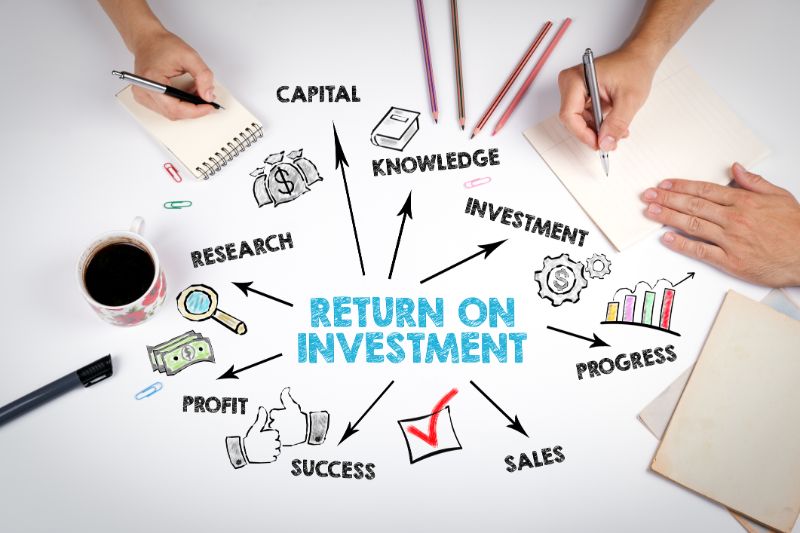
With its clear skies, sunny weather, and easy access to California’s top beaches, Culver City has become home to both celebrities and the entertainment industry. Only a half-hour away from Downtown Los Angeles, this city houses Sony Pictures Studios, Columbia Pictures, TikTok, and Apple, among others. It is no wonder that Culver City is currently a prime site for selling investment property.
In fact, real estate in Culver City is among the priciest not only in California but also in the whole of the United States. In 2021, its median home price hit an all-time high of $1.3 million. In October 2021 alone, homes were sold at an average price of $870,000. Buyers snapped up Culver City’s hot property at as much as 7% above list price. While the city’s homes usually stayed in the market for around 39 days, in-demand estates took only 22 days before they were sold.
What’s in this article:
- The right time to sell investment property
- Understanding capital gains tax
- How to reduce the impact of capital gains taxes
- What is ROI?
- On selling investment property with tenants
- How to sell fast and at the highest profit
- Selling investment property checklist
- Work with the Right Real Estate Agent
The right time to sell investment property

Selling investment property is all about proper timing. To gain the highest profits, one should have extensive knowledge of the property market or hire someone who does. An experienced agent or Realtor can tell owners the best time for selling investment property.
In a seller’s market, the demand for real estate is higher than the supply. When buyers are competing for available properties, sellers have the upper hand and can therefore raise prices. But when it is a buyer’s market, there are more estates for sale than interested investors. Because of the stiff competition, sellers have less opportunities to close a highly profitable sale.
However, the definition of “good timing” may also be based on these personal situations:
- Securing retirement. Many choose to let go of real estate to beef up their funds during old age. But before doing this, they need to know how the sale will impact their retirement benefits. This is because a successful sale counts as income even when the seller is retired.
- Cutting one’s losses. When property prices in their area are going down or at a standstill, some owners opt to sell fast before things get worse. They know that time spent holding on to a tepidly growing property equates to financial loss.
- Ensuring cash flow. People usually invest in real estate to ensure their financial security during tough times. With unexpected hits on finances, some turn to their assets for salvation. Still, selling property takes time. This is why it pays to regularly evaluate one’s property portfolio. Owners must identify the most profitable ones, which are the first to sell when they need cash.
- Grabbing a better investment opportunity. Some decide to sell property to finance a more lucrative venture. A better opportunity means a higher investment return than their current property generates.
In a nutshell:
Knowing the right time to sell investment property involves deep market knowledge and individual circumstances. Holding on to property may give owners better profit if they sell in an ideal market situation. On the other hand, property maintenance costs can get expensive. Depending on their situation, it may be better for them to sell and reinvest.
Understanding capital gains tax

In real estate, capital is what an investor spends to buy property. When the investor is able to sell the same property for a higher price, capital gain is realized. But this win comes with a payback – the Capital Gains Tax (CGT).
CGT may be short-term or long-term. When investors unload property they have had for less than a year, the gains are considered short-term. The government taxes these as ordinary income. But if the property remains in the owner’s hands for a year or more, the gains fall under the long-term category.
The tax rate, which varies from 1% to 12.3%, depends on the amount of capital gains and whether the seller files the tax as:
- A single taxpayer
- Married filing jointly
- Married filing separately
- Head of the household
But sellers need to note that computing for capital gains does not only involve profit. They should also consider the “cost basis,” which includes fees for the title, legalities, transfer, and taxes related to the acquisition. Other charges may include major upgrades on the property and professionals’ commissions.
So, when selling investment property, sellers should also subtract all these other costs from their net gains. A negative sum indicates a loss, while a positive sum means a gain.
How to reduce the impact of capital gains taxes

Though taxes are as inevitable as death, there are ways to make CGT more manageable.
Counter gains with losses
The technical term, “tax-loss harvesting,” means that upon selling property, sellers can subtract from their gains the losses they incurred from other investments. Stockholders have long used this tactic for their gains. But now, more and more real estate investors are catching on. For instance, an owner sells their home at $60,000 more than what they bought it for. In the same tax year, however, the owner’s stock investments lost value. The owner can then sell the stocks at a loss of $60,000 to offset their gains from selling property, thereby lowering their tax liability.
Reinvest earnings from the sale
Section 1031 of the tax code is also known as a “like-kind” exchange. Here, investors can delay paying CGT when they reinvest the gains into a similar asset. What defines a like-kind property? Real estate should be exchanged for real estate. A caveat though – this does not include personal or vacation homes, so the property must be used for business or investment purposes.
Another reminder: time is of the essence for the 1031 strategy. After selling investment property, investors have only 45 days to choose three possible and similar future investments. They must buy this new property either within 180 days of the previous sale or before the due date of their tax returns, whichever comes earlier.
There is no limit to the number of times investors can use this tax-deferring strategy. However, once they stop reinvesting their gains, they have to pay CGT.
Make your investment property as your main residence
This tip is based on the tax code’s Section 121, which lets investors shed $250,000 off their CGT if they sell their primary home. The tax exemption doubles at $500,000 for married couples filing a joint return. Though this strategy may seem confusing for investors who have no plans of selling their principal homes, they first need to understand how Section 121 defines a primary residence. Basically, a main residence meets the following conditions:
- If the investors lived in the property for two of the five years before the home is sold.
- These two years of residence do not need to be successive. This means that the investors can live in the property for a year, and rent it out for four years before taking up residence again and putting it up for sale.
Sell part of your investment property
To reduce CGT, some investors opt to incorporate. With more people owning the property, the financial hit from paying taxes becomes more manageable.
Factor in depreciation
By their very nature, rental properties are exposed to more wear and tear than primary homes. Tenants have varying levels of home care, which may work for landlords in case they plan to sell in the future. To make a depreciation claim upon selling, owners must submit the Depreciation and Amortization form (no. 4562) in the first year they are renting out the property. They should also do this in the year they make upgrades or add fixtures to their rentals.
In a nutshell:
Gains are great, but if investors do not watch out, CGT can significantly eat into their profits. The good news is that there are smart strategies to reduce, avoid, and defer CGT so sellers can protect their finances. A tax professional can help them choose the approach that suits their preference and situation.
What is ROI?

ROI or return on investment is an important part of buying and selling investment property. It is what investors calculate to gauge the profitability of a specific piece of real estate before buying it. To find out the ROI, which comes in percentage form, net gain is divided by the amount spent on the purchase. Cost is not just what you paid the property seller, but also other expenses such as mortgage fees, improvements, and repair.
Computing an accurate ROI for real estate can be tricky because it involves maneuverable elements. For example, one can boost ROI by using financing to buy property. Even if this option increases the balance of mortgage loans, it also increases ROI because less cash was paid in the beginning.
In a nutshell:
ROI can be easily manipulated in real estate. Still, investors should take ROI into consideration before making a decision to buy or sell investment property. In general, real estate is a sound investment whether the economy is healthy or on the decline. Investors should snap up affordable properties during a recession. Once the economy recovers, they can sell these investments at considerable profit.
On selling investment property with tenants

Before putting up tenanted property for sale, investors should ask themselves these questions:
- Is the potential buyer a fellow investor?
When selling rentals, which is the smarter option – selling while there are still tenants or selling after tenants have vacated? If the interested party also plans to rent out the property, then keeping the existing tenants may work. This is especially true if the current rent follows competitive market prices. On the other hand, if the buyer wants to live in the property, then the seller needs to let go of the tenants following the proper procedure. - Do you have enough time to inform your tenants?
Selling property while it is tenanted ensures the investor’s cash flow. But tenants will need to be informed and given enough time to move out. Aside from being common courtesy, this practice is also dictated by law. That is why investors need to include a clause that allows for the lease’s early termination in case they want to sell. Additionally, landlords should also review state regulations on such matters. - Do you need immediate cash?
Selling right away can immediately boost the investor’s liquidity. But if cash is not a concern, it might be better to wait before selling. This is a long-term, wealth-building technique whose benefits can be maximized during retirement. However, this also depends on extraneous factors such as the real estate market. If the market has been favorable for buyers and you want to cash in before conditions worsen, it is wiser to immediately sell and reinvest. - Are you willing to let go of your passive income?
Remember that once you sell your rental, you are foregoing potentially more years of passive income. A successful sale may guarantee a huge amount of cash, but it also marks the end of your steady investment gains.
In a nutshell:
Whether owners are planning to sell their property with or without tenants, respect is key. When tenants feel valued, they are more open to beautifying their space and receiving prospective buyers during house tours. A good relationship with tenants goes a long way, especially in facilitating a smooth sale.
How to sell fast and at the highest profit

Selling investment property involves a lot of logistics. So, if investors want to unload their real estate at the earliest time possible at the best price, they have to plan ahead.
Here are some tips:
Make improvements
Even before putting the property in the market, it should already look ready for inspection. This does not mean making major renovations. Depending on the seller’s budget, small upgrades such as repainting fences or replacing furniture can give the home a winning edge. Basics like lighting, electrical components, and the bathroom should be in good condition. Sellers must try seeing their property through a buyer’s eyes to gauge what simple yet significant repairs they can do to make it look more attractive.
Sell at the right price
This is a decision that should be made with care and research. Ideally, the right price meets the target buyers’ expectations while bringing the highest gains for the investor. The selling price is based on several things such as the property’s size, location, and the original investment. But sellers also need to analyze the current real estate market. By looking into similar properties listed on the market, they can better decide on a competitive price. Nonetheless, proper price setting is better achieved with market analysis. Realtors and agents can help sellers make an informed decision on pricing, which draws in potential buyers.
Market effectively
Effective marketing is not just about placing ads in the papers. To gain exposure for their property, sellers first need to identify their target market. What do they like doing? What do they read? What do they value? The answers to these questions can guide sellers in crafting a strategy that zooms in on potential buyers. For example, does the target market profile fit the same people in the property’s neighborhood? Then sellers should post ads in the community newsletter, social media groups, and strategic spots within the vicinity. Ads should be on point – from headline to photos that will literally put the property in its best light. Hosting open houses can also attract walk-in clients.
Make counteroffers
It goes without saying that the best time to sell property is in a seller’s market. In this state, sellers can politely decline lowball offers because they know that more inquiries will be coming in. But in a buyer’s market, sellers should seriously consider offers made below their asking price. However, it is within the seller’s purview to make a sensible counteroffer. If buyers continue to pursue the property, it means they are genuinely interested.
In a nutshell:
Preparation is key to pulling off a quick sale. Researching and grooming the property ahead of time demonstrates a seller’s diligence and dependability. Preparation also helps manage a seller’s stress levels.
Selling investment property checklist

Selling investment property involves many steps. Here is a step-by-step guide to better illustrate the process:
- For rented property, give tenants a heads up on the impending sale, and ample time for them to prepare.
- Stage the property before the sale. Make minor upgrades to make it look desirable inside and out. This potentially enhances the perceived value of your property.
- Decide on the most competitive selling price.
- Contact a lawyer to prepare a deed of sale.
- Choose the best marketing plan for your property.
- Negotiate offers on your own or through a Realtor.
- Accept the best offer and decide on a settlement date.
- Review paperwork and get payment.
- Close and transfer utilities.
- End the deal by giving your buyer a hassle-free experience when they move in.
Work with the right real estate agent

Hiring an agent or Realtor is a big decision, but it may be one of the best decisions sellers can make. In return for services that will save time and money, sellers must be prepared to pay a commission based on a small percentage of the sales price.
Working with a Realtor means:
- Taking advantage of a Realtor’s extensive knowledge of the real estate market. As a result, they can guide sellers on the best time to sell, how to sell, and decide on the best offer.
- Being assured of a smoother sales transaction.
- Enabling the buyer to choose a real estate professional with considerable experience in selling investment property in their particular area. Their track record, achievements, and wealth of experience should be noted.
Ready to buy or sell investment property in Culver City? Let my 37 years of expertise, along with my experience in my own property management company, guide you in closing the best possible deal.
Call me, Martin Feinberg, today at 310.729.6573 or send an email to martin(at)martinfeinberg(dotted)com.